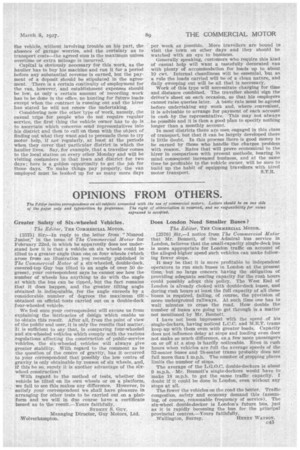OPINIONS FROM OTHERS.
Page 67

If you've noticed an error in this article please click here to report it so we can fix it.
The Editor invites correspondence on all subjects ronnected with the use of commercial motors. Letters should be on one side of the paper only and typewritten by preference. The right of abbreviation is reserved, and no responsibility for views expressed is accepted,
Greater Safety of Six-wheeled Vehicles.
The Editor, THE COMMERCIAL MOTOR.
[2575] Sir;—In reply to the letter from "Nimrod Junior," in the issue of The Commercial Motor for February 22nd, in which he apparently does not understand how it is that a vehicle on six wheels could be tilted to a greater angle than one on four wheels (which arose from an illustration you recently published in The Commercial Motor of a six-wheeled, double-deck, covered-top Guy bus tilted to an angle of over 50 degrees), your correspondent says he cannot see how the number of wheels has anything to do with the angle at which the bus can be tipped,but the fact remains that it does happen, and the greater tilting angle obtained is indisputable, for the angle exceeds by a considerable number of degrees the maximum tilt obtained on official tests carried out on a double-deck four-wheeled vehicle.
We feel sure your correspondent will excuse us from explaining the intricacies of design which enable us to obtain this result. After all, from the point of view of the public and user, it is only the results that matter. It is sufficient to say that, in comparing four-wheeled and six-wheeled vehicles which comply with the various regulations affecting the construction of public-service vehicles, the six-wheeled vehicles will always give greater stability. With regard to the comment as to the question of the centre of gravity, has it occurred to your correspondent that possibly the low centre of gravity is only obtainable by reason of six wheels, .and, if this be so, surely it is another advantage of the sixwheel construction?
With regard to the method of tests, whether the vehicle be tilted on its own wheels or on a platform, we fail to see this makes any difference. However, to satisfy your correspondent we shall have pleasure in arranging for other tests to be carried out on a platform and we will in due course have a certificate Issued as to the result. —Yours faithfully, SYDNEY S. GUY, Managing Director, Guy Motors, Ltd. Wolverhampton.
Does London Need Smaller Buses ?
The Editor, THE COMMERCIAL MOTOR.
[2576] ,Sir,—I notice from The Commercial Motor that Mr. Bennett, of the Admiral bus service in London, believes that the small-capacity single-deck bus is more appropriate for London traffic on account of the alleged higher speed such vehicles can make following fewer stops.
It may be that it is more profitable to independent operators to run such buses in London at the present time, but no large concern having the obligation of providing adequate seating capacity for the rush hours could possibly adopt this policy. The West End of Loudon is already choked with double-deck buses, and during rush hours at least the full capacity of all these buses is required, failing, of course, the provision of more underground railways. At such time one has to wait minutes to cross the road. How double the number of buses are going to get through is. a matter not mentioned by Mr. Beneett.
I have not been impressed with the speed of his single-deckers, having noticed L.C.C. and M.E.T. trams keep up with them even with greater loads. Capacity does not influence delay at stops and loading even does not make so much difference, as •a few more passengers on or off at a stop is hardly noticeable. Even in rush hours when vehicles are full the average speeds of the 52-seater buses and 78-seater trams probably does not fall more, than 1 m.p.h. The number of stopping places limits the number of stops.
The average of the L.G.O.C. double-deckers is about 9 m.p.h. Mr. Bennett's single-deckers would have to make 18 m.p.h. to get the same traffic capacity. I doubt if it could be done in London, even without any stops at all.
The fewer the vehicles on the road the better. Traffic congestion, safety and economy demand this (assuming, of course, reasonable frequency of service). The six-wheel double-.decker is London's future bus, just as it is rapidly becoming the bus for the principal provincial centres.—Yours faithfully, Wallington, Surrey. HENRY 'WATSON.












































































































